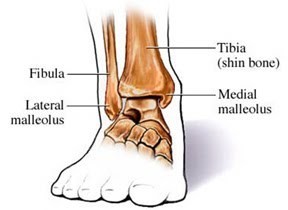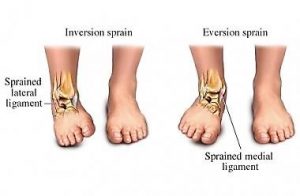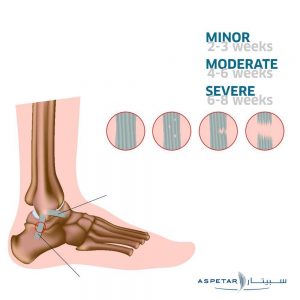Ankle Sprain: From Injury to Full-Recovery
Locked up in a home-quarantine due to the coronavirus outbreak?
You must also be concerned about the ankle rehabilitation appointment you were planning to make – but never did.
No worries, your safety is our priority.
With current (hopefully ending soon) our social distancing policy, your online personal ankle treatment is now one click away.
Because your safety comes first, as a top London injury rehabilitation online personal trainer I am answering all your questions online on one-to-one basis through a high quality video application.
Here are few things about your ankles:
Top Tip: Never under-estimate your ankles!
Have you ever experienced ankle pain?
If the answer is ‘Yes’, then you probably know how disabling ankle pain is.
Well, I know ankles are not usually our biggest concern.
However, after reading this article, I bet you will address your ankles as your SUPERHERO joints.
This is because these tiny joints of yours not only carry your whole body weight, but also allow you to move freely without losing your balance.
Interesting, isn’t it? Now let’s reveal more facts about your ankle joint that will make you forever-thankful!

What Makes the Ankle Joint?
You must have heard of the shinbone, the big bone of our lower leg.
Well, that is the tibia.
Together with the smaller bone right next to it -the one we call the fibula- they form the concave lower end of our leg so called the ankle mortise.
The ankle mortise is where the convex great heel bone (talus) lies forming the hinge joint known as the ankle joint.
Because the talus lies within the concavity of mortise with its relatively bigger size, the lower ends of tibia and fibula are pushed apart, they pop out forming two pumps (protrusions) which you can see and feel on both sides of our ankles.
These pumps are known as:
- Medial malleolus: the pump on the inner side of our ankles
- Lateral malleolus: the pump on the outer side of our ankles
I know these pumps don’t look pretty as much on each side.
However, you will be thankful when you know that they give attachment to the important structures responsible for not letting your ankle give way very often.
These are: joint capsule, ligaments and tendons.
Here is a secret you shouldn’t keep: the joint capsule and the ligaments are passive structures; they allow for movement, but they do not initiate it.
So, they are only responsible for the stability of the joint. On top of that, they are not contractile.
That means you can’t make them stronger with exercise! [1]
Don’t forget: Ligaments are fibrous bands that extend from a bone to another for the sake of stability.
Now let’s meet the ligaments of the outer side of our ankles:
- Anterior Talo-fibular ligament: this ligament is a weak band extending from the talus bone to the fibula.(hence the name Talo-fibular).
The word anterior means that it is directed forward.
- Posterior Talo-fibular ligament: this ligament is also extending between talus and fibula. However, it is directed backward.
It is also a stronger ligament than the anterior ligament.
- Calcaneo-fibular ligament: a vertical cord extending between the heel bone (calcaneus) and the fibula, it is directed downward.
If you are wondering about the ligaments of the inside of your ankle, here is a fact: The inner side has only one ligament; that is the Medial Ligament of the ankle (Deltoid ligament). [1]
Why our ankles get twisted.
Our ankles’ unique design allows for movements in all direction. Let’s give it a try.
- Pull your foot up. This is the movement known as dorsiflexion.
- Point your toes. Well, that is planter flexion.
- Clap your feel. That is inversion
- Move your out. That is eversion
You might be surprised of how capable your ankles are!
But you need to know that ligaments are not much of stretchable structures; they only allow for the ankle to move throughout its normal range.
Let me put it differently: If your bones are pushed beyond this range, your ligaments may get overstretched, injured or even torn.
Just like the tragedy of twisting your foot while going downstairs.
I KNOW! EVEN THINKING ABOUT IT IS PAINFUL.
Now that you know more about the ligaments on each side, you can definitely guess what happens when you get your ankle twisted.
OF COURSE, when your foot is twisted inward one of the outer ligaments is injured.
This is called an inversion sprain.
When the opposite is the case, it is called an eversion sprain.[1],[2]
Well, It is not a coincidence that inversion ankle sprain is more common. Let me tell you why: [1],[2]
- Our ankles allow more movement inward than outward, this makes outside ligaments more prone to overstretch than the inner ligament.
- The Deltoid ligament is a very strong ligament. [1],[2],[4]

Here is an ankle hack from the best sprained ankle’s trainer in London: Every time your ankle twists doesn’t necessarily mean your ligaments are sprained. There are symptoms that you need to see before making a decision
So, is it sprained?
Here is your guide to decide whether your ankle is sprained. To do so, look for the following signs and symptoms:
- Pain
- Swelling
- Bruising
- Difficulty bearing weight on the injured ankle
If you are still unable to decide whether your ankle is sprained or not, you can simply use an expert’s opinion by requesting your online free consultation right away.
Simply click here and fill in the form.
If your ankle is sprained, the next step is to figure out how severe the sprain is.
Ankle sprain’s symptoms vary in severity according to the grade.
Grade I ankle sprain means the injury is mild, while grade III means the ligament is completely torn.
It is difficult for you to determine the grade of your injury, but a person with relevant experience like your personal rehabilitation specialist, physiotherapist or clinician can help you figure out. [2], [3], [4]
Ankle hack:
It is important to ask your physician or physiotherapist about the grade of your injury and how it will affect your recovery before starting your ankle sprain exercises.
If your injury is mild and is of the first grade, it will take up to 2-3 weeks to heal.
While a moderate injury of the second grade has a recovery period of up to 6 weeks.
A fully torn ligament, however, can take months to heal and return to normal function. [4],[7]

BE FAST!
If your ankle is sprained, you need to react right away in order to prevent worsening of the injury.
Learn and follow the PRICE protocol for the first 24-48 hours until the symptoms. PRICE stands for:
- Protection: Protect the injured ankle from any movement or strain that may worsen your injury.
Try to offload your ankle as much as you can.
- Rest: Rest is vital in the first day following injury.
- Ice: immerse your foot in a bath of cold water or apply ice on the site of injury (15-20 minutes) and repeat the application 2-3 times aday.
- Compression: Apply a bandage, a wrap or an elastic ankle sleeve to control the swelling.
- Elevation: keep your injured foot elevated above the level of your heart in order to reduce and control the swelling. [4],[5]
Ankle hack:
An ankle X-ray is not routinely done to evaluate ankle injuries. However, if you cannot bear weight at all, if your symptoms are severe and you are not improving, you can talk to an expert about your condition while staying safe at home. Hit here for a free consultation!
Here are more tips and tricks on what to do if your ankle is sprained:
- Avoid taking hot showers, sitting with your injured foot dangling and overloading the injured ankle.
- Non-steroidal anti-inflammatory drugs can help reduce your pain and swelling.
- Seeing your physiotherapist at this stage can be helpful as some physiotherapy modalities might help reduce inflammation, swelling and pain. [6]
Take it seriously!
Ankle sprain is a pretty common injury among people and athletes.
This makes people shake it off and think it does not need the medical attention it actually needs.
DON’T BE ONE OF THEM!
If you sprain your ankle, make sure you are following the right steps so you don’t have to go through its serious complications.
Ankle hack:
If it is your first time injuring your ankle, it might not be long until your ankle is no more painful or swollen. However, you are at risk of developing complications of ankle sprain. That is why you need to take it seriously.
Complications of ankle sprain:
- Recurrence
Spraining your ankle once probably means that more ankle sprains are waiting ahead of you in the future (yep that’s bad news).
Good news is: you can prevent recurrence if you deal with your ankle sprain the right way.
I know the life schedule might be hectic, especially in London.
Specify some time to see your physiotherapist in order to address the risk factors and reverse them.
- Stiffness
If your ankle swelling does not fully subside, your ankle range of motion will be restricted.
This might lead to a permanent decrease in your range of motion and may affect the way you walk.
DON’T BE AFRAID!
If you manage to control the swelling as soon as it takes place, you will be safe.
- Chronic pain
No one likes to tolerate pain.
In case of an ankle sprain, you can never tell where the pain is exactly coming from.
Sometimes, there might be a hidden injury within your foot that will remain undiagnosed.
Remember that different types of injuries require different treatments, if your injury remains under- or undiagnosed, you are at risk of not fully recovering from the injury due to lack of proper treatment.
- Arthritis
It is important to make sure your bones are properly aligned. In case of misalignment, abnormal loading on your bones may lead to arthritis not only in the ankle joint itself, but also in other joints like the small foot joints, the hip and, more commonly, the knee.
Well, it is already estimated that a total of 557 people in the City of London live with knee osteoarthritis. DON’T ADD MORE TO THE NUMBERS! [9]
- Ankle instability
A sprained ankle means the muscles around the ankle joint failed to compensate for the overstretched ligaments. YEP, THAT MEANS YOUR MUSCLES ARE WEAK.
In addition, if you spend days trying to place minimal weight on your injured ankle, your muscles become even weaker.
Therefore, the stability of your ankle is reduced.
Post-sprain rehabilitation programs must focus on restoring the joint’s stability in order to prevent recurrence.
What comes after you feel you recovered?
After an injury to your ankle, you might start feeling better and think that you do not need further rehabilitation. GUESS WHAT? You are wrong!
The important part of an ankle sprain rehabilitation program starts after your pain is gone.
I KNOW PAIN IS ALWAYS THE MOST ANNOYING PART OF AN INJURY.
Yet, it is not always the most important thing to consider from a rehabilitation specialist’s point of view.
The actual goal of rehabilitation after ankle injury is to restore normal function of your ankle and to prevent further complications.
Here is a priority list from your number one rehabilitation specialist in London:
Out of many – here are just four of some of the most important rehabilitation priorities:
- Structure, body segments, posture and bone alignment
- Mobility
- Stability
- Balance
If your rehab program contains all of the four items, I promise that your ankles will be back as new [8]
Here is a hint on what we can do to reach your rehabilitation goals:
1. Restoring bone alignment
You need to make sure that your bones are resting in their normal anatomical position and moving through their normal range of movement without excessive friction, pain or difficulty.
If this is not the case, NO WORRIES, there are some manual techniques that can help your bones regain their normal position.
These techniques are specifically carried out by your physical or manual therapist. [8]
2. Mobility
Mobility means that your joint must be free to move without facing any restrictions.
You might wonder, Why would the joint be restricted anyway?
Well, a swollen ankle might cause some limitation in the ankle range of movement.
If your ankle is swollen and restricted, bandaging, cold application and elevation maybe helpful.
Your physiotherapist may also use different techniques such as electrotherapy and hydrotherapy.
The restriction may also be due to shortening in your soft tissues.
You can perform simple range of movement exercises to keep your ankle mobile in all directions.
Simply move your ankle in all possible directions, and in pain-free ranges.
You can also do the ankle alphabet exercises; in this exercise you have to lie on your back and draw all the capital letters using your ankles.

If the restriction is due to muscle shortening, you will need to perform stretching exercises in order to regain full muscle flexibility.
Sure, you can focus more on your calf muscles and the muscles around the ankle.
You can stretch your muscles on your own, or you can use simple aids as the wall, bands or the help of a therapist or a friend. [8]

3. Stability
As I told you earlier, the stability of your ankle depends on the structures that surround it.
After ankle injury, the first step towards a stable ankle is to allow proper healing of the ligament.
Prepare your popcorn, and spend the first 24 hours following injury resting at home while the injury is still fresh.
As your pain disappears, you can start strengthening your muscles.
Strengthening the muscles around your ankle must start lightly and increase gradually.
For exercising, you can simply use your body weight.
You can practice standing on your tiptoes to strengthen your calf muscle, you can also use your hand to resist inversion and eversion in order to strengthen your invertors and evertors respectively. [8]

As your calf muscle gets stronger, you can use external weights such as sand bags, ankle weights, and resistance bands (also known as Thera-bands), or machines like the calf-curl or calf-raise machine at the gym.
4. Balance
CLOSE YOUR EYES. Now think where your foot is and how it is positioned, is it supported on a surface? Is it dangling freely?
You exactly know the state of your feet because you have specific receptors in your joints, ligaments, muscles and all other soft tissues.
These specific receptors are known as proprioceptors (DID YOU EVEN READ THE NAME? :)).
Proprioceptors convey feedback to our brain about all body segments and whether they are still or moving.
Our ankles have a huge number of proprioceptors, that is how we gain our balance.
After ankle injury, damage to the soft tissue leads to loss of some proprioceptors and hence affects our balance this is why balance training must be a part of your ankle sprain exercise routine.
Ankle hack:
If you have had an ankle sprain, you have to consider proprioceptive training as soon as you can bear full weight on your ankle.
If you are not sure when exactly to start bearing weight on your foot, don’t hesitate to contact me for a free one-to-one consultation! You will get personalized advice on when you can get back to the track. Follow this link and contact London’s best personal trainer for your ankle sprain treatment.
Proprioceptive training is done by standing on a soft, unstable surface.
This can be a spongy mat or a foam roll.
You can also include standing on a narrow base such as standing on one leg or standing on a moving surface like a balance or a wobble board. [8]

As you progress in your training, CHELLENGE YOUR BALANCE!
Add activities to do while trying to balance on a board, catch and throw a ball, move your arms in different directions, shift your weight by leaning forward or side-to-side.
JUST BE CAREFUL NOT TO FALL!
A tip from number one ankle’s personal trainer in London:
If you want to challenge your proprioception, close your eyes while performing your balance training. Blocking visual feedback makes your body more dependent on the information provided by your proprioceptors.
REMEMBER: Balance is the coordinated integration between mobility, stability and proprioception.
If all three are considered in your ankle injury rehabilitation programme, balance can be achieved successfully.
Now, did you manage to set your own rehabilitation program?
If you need a tailored plan for your own with supervision and follow-up from a specialist, we’ve got you covered!
Click here and request your personal free consultation.
In a nutshell,
Never take ankle sprain lightly!
The acute symptoms may resolve in a week, but its complications may cause you life-time harm.
Always start your personal ankle treatment early and try to address the problems before they become even more problematic.
If you already have had ankle sprain, it is time to go the right way towards never experiencing it again!
AND…
Remember, it is always easier to prevent complications than treat them
References
- MOORE, K. L., DALLEY, A. F. and Argur A. M. (2017). Clinically oriented anatomy. Philadelphia, Lippincott Williams & Wilkins.
- Roos KG, Kerr ZY, Mauntel TC, Djoko A, Dompier TP, Wickstrom EA. The epidemiology of lateral ligament complex ankle sprains in National Collegiate Athletic Association sports. American journal of sports medicine. 2016.The American Journal of Sports MedicineVol 45, Issue 1, pp. 201 – 209
- Lynch S. Assessment of the Injured Ankle in the Athlete. J Athl Train 2002 37(4) 406-412
- Van der Wees PJ, Lenssen AF, Feijts YAEJ, Bloo H, van Moorsel SR, Ouderland R, et al. KNGF-Guideline for Physical Therapy in patients with acute ankle sprain. Dutch J Phys Ther. 2006; 116(Suppl 5): Available from: https://www.kngfrichtlijnen.nl/images/imagemanager/guidelines_in_english/KNGF_Guideline_for_Physical_Therapy_in_patients_with_Acute_Ankle_Sprain.pdf
- Van den Bekerom MP1, Struijs PA, Blankevoort L, Welling L, van Dijk CN, Kerkhoffs GM., What is the evidence for rest, ice, compression, and elevation therapy in the treatment of ankle sprains in adults?. Journal of Athletic Training. 2012
- Bleakley CM, McDonough SM, MacAuley DC., Some conservative strategies are effective when added to controlled mobilisation with external support after acute ankle sprain: a systematic review., The Australian journal of physiotherapy. 2008;54(1):7-20. Available from: https://www.ncbi.nlm.nih.gov/pubmed/18298355/(Level of evidence 3a)
- Adapted from Maughan KL, “Ankle Sprain,” UpToDate, version 14.3, and Ivins D, “Acute Ankle Sprain: An Update,” American Family Physician(Nov. 15, 2006), Vol. 74, No. 10, pp. 1714–20.
- Kisner, C., Colby, L. and Borstad, J. (2018). Therapeutic exercise. 9th ed. Philadelphia, PA: F.A. Davis Company.
- Public Health Outcomes Framework accessed via http://www.phoutcomes.info/ 28th September 2014.



